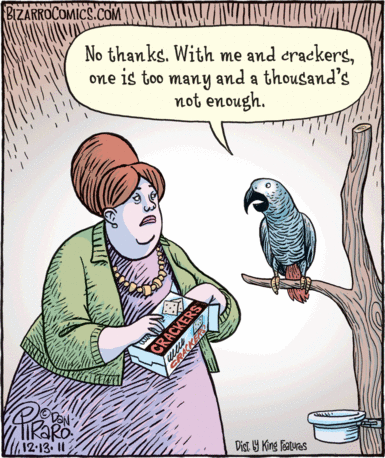Unconventional Contractions
Apostrophes’ main use is for contractions, I think. More on that later.
Apostrophes are also used for quotes inside quotes; in fact, the rule is you alternate single and double quotes as you nest them.
The student told me, “Our teacher said ‘Don’t use the fire escape until I say “GO!”.’.”
Technically you don’t need spaces between the marks when they fall together, but I would have used them because I want you to be able to see clearly what I’m doing. But I lucked out because I need a period for each sentence.
Another use for apostrophes is to show possession. Technically that is also a contraction; the possessive used to be “-es,” and we took out the “e” and replaced it with an apostrophe.
Contractions. Perhaps the most common contraction is n’t for not, but you can use it to shorten verb forms, such as the present perfect: “could’ve” instead of “could have.” You can shorten the future, too: “we’ll” instead of “we will.”
Then sometimes jargon shortens words, and the correct way to show the shortening is with apostrophes, hence this Frazz:
And I ran into this verb-form shortening with an uncommon, but perfectly correct contraction, brothers’ve:
Here are two rules:
In formal writing, avoid most contractions. Don’t use them unless they improve the writing.
Nowadays, most of the time, the –n’t contraction is okay to use.
Subscribe to this blog's RSS feed
Apostrophe humor
I have mentioned apostrophes now and then, so don’t expect much new today. This comic, by Jon Kudelka, who might be an Australian, appeared recently, though, and I can’t resist repeating myself.

How many apostrophic solecisms can you count?
Apostrophes are replacements for letters you leave out of a word. The apostrophe as the sign of the possessive in nouns (not pronouns!) came from the German, where the possessive ending is usually -es. We take out the e.
Rule 1: Plurals don’t get an apostrophe, even if you’re writing grocery store vegetable signs.
Rule 2: For possessives, look at the noun (not pronoun!) that you want to make into a possessive. If it ends in an single s, put an apostrophe on the end and you’re done. If it doesn’t end in s, add apostrophe s.
Rule 3: You don’t need an apostrophe to pluralize an acronym.
Want a couple complications?
Complication 1: If the word you want to pluralize ends in a vowel or laryngeal sound before the s, you do the apostrophe followed by nothing, but you pronounce the missing -es ending. For example, “Jesus’ Sermon on the Mount” is pronounced “Jesuses Sermon etc.” and my first name, “Rogers,” has the possessive form “Rogers’ ” and you pronounce it “Rogerses.” Both of these, with the -es, are how you spell and pronounce the plural, by the way.
Complication 2: Use apostrophe s for the possessive of acronyms, even if the acronym ends in ss (for example, the Office of Strategic Services is the OSS). This is the only time in English where you can have three of the same letter in a row. “The OSS’s pronouncement” is grammatical. (Okay, onomatopoetic words can have any number of repeated letters. A snake goes “ssssssss,” and a cow goes “moooo.”)
Complication 3: Pronouns have their own possessive forms: my, your, his, her, its, our, your, their. No apostrophe! That’s not really a complication, is it?
A good way to ruin a nice piece of wisdom
I don’t usually blog about typographical errors because I tend to assume that they are more a slip of the finger than of the intellect. Just the same, I can think of a couple places where typos are verboten. Your résumé is one. Aphorisms are another.
As a rule, any time you leave a stupid mistake in something you write, it gives the lie to your competence, wisdom, status; whatever your writing is trying to accomplish. (Since I write about mistakes in writing so much, I even proofread my emails and instant messages. People are delighted when they find that I made a goof.)
Here’s a case in point.
A nice piece of wisdom, perhaps, but you wonder who would allow that apostrophe in there. I’ll give the writer the benefit of the doubt and say it was a slip of the finger, but I still say PROOFREAD!
The parrot is correct
Here’s a comic I ran into recently. The parrot got three things right that a lot of folks get wrong. Bizarro is generally pretty funny, by the way, and I recommend it.
 The first thing is he mentioned himself first. Yes, this is opposite of an aside I made in a recent post about case. Normally, out of humility, you’re supposed to mention yourself last, but it’s not necessary to put yourself behind inanimate objects, and he’s talking mainly about himself anyway.
The first thing is he mentioned himself first. Yes, this is opposite of an aside I made in a recent post about case. Normally, out of humility, you’re supposed to mention yourself last, but it’s not necessary to put yourself behind inanimate objects, and he’s talking mainly about himself anyway.
Second, he used the correct case. Many people would have said “With crackers and I…” and this is wrong. Object of a preposition—use “me.”
Third, a lot of folks would have missed the apostrophe in “a thousand’s.” It’s a contraction of “thousand is.”
Fourth, he didn’t point out that his mistress had eaten a few too many crackers herself.


